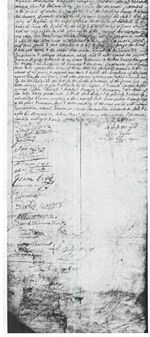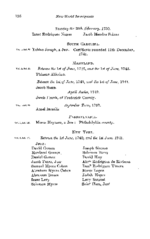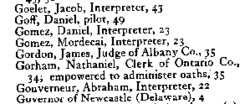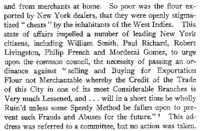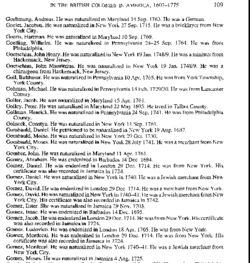User:DanielTFrom The Peopling of New York CityDANIEL THENGONE After reading Jill Lepore's New York Burning, I was fascinated by this less well-known topic of slavery in New York City. The objective of this project is to search for those immigrants,who have been a part of the history of New York City, but have not been prominent. My search for the five slave owners assigned to me led me to the geneology database www.ancestry.com. With this minimal information, I ventured to the New York Public Library, where I spent several hours glancing through books, journals, city directories and such census-related books. It was fascinating to go through these ancient documents and journals, some of which were in really bad condition. After searching for the "elusive immigrants" I was not able to find much. This scrutinizing process was very enlightening, although it did not bear me much fruit in regard to my project. But it did give me enough information to choose my next destination which is the Municipal Archives.
Research Project ProposalFor my research, I would like to focus on the slave owners of New York City. Therefore I will be working on the slave conspiracy After reading New York Burning by Jill Lepore, I became interested in finding out more about these slave owners. The events that occurred between the slaves and these owners have led to the establishment of several political and social liberties that are present today. To further understand these issues, I feel that tracking the lives of these slave owners will be beneficial to the study of the slaves in New York City. For my research I have been interested in the following people. Capt. Josiah Bagley, who was of French ethnicity owned a slave named Jemmy. Stephen Bayard was a Dutch merchant and a slave trader who owned slave named Ben. Mordecai Gomez, a Jew was a merchant who owned a slave named Cajoe (Africa). He was also a slave trader. Dr. James Henderson, an Englishman was a physician who owned a slave named Caesar. Ebener Pemberton, another Englishman was a minister, who owned a slave named Quamino. Cornelius Van Horne was a Dutch merchant who was involved in the slave trade and owned a slave named Kid. John Tiebout was a Dutch blockmaker, who owned a slave named Jack, and was also a slave trader. Capt. Jacob Sarly was a Dutch mariner, who owned a slave named Juan de la Silva. John Provost was a Dutch merchant who owned a slave, Lowe, and was also a slave trader. Capt. Robert Livingston Jr. was a English lawyer who owned a slave named Tom. Slavery has been a major issue in the country that has led to the development of significant laws and court decisions. This topic has interested me because I have always wondered the plight of these slaves, and their owners. Although there is the tendency to view these owners as mere ruthless people, I wondered if all the slaves were treated alike. This research into the lives of slave owners will enable me to better comprehend the ambiguities and truths present in the slavery in New York City, and even the slave trade itself. Slave OwnersSlave owner: Ethnicity; Wealth; Party affiliation; Occupation; Ward; Slave's name; Slave's final outcome
ResearchJohn Chambers
My search for John chambers was a particularly tedious one. My exploration began in Lepore’s New York Burning which gave me information regarding his slaves. With very minimal information I began my journey by first searching online on www.ancestry.com and then extended my research through city directories at the New York Public Library. As I had expected I was bombarded with nearly hundreds of people named John Chambers. Although this was a major predicament, I was able to utilize the given information from Lepore’s book to my advantage. The main clue that enabled me to rule out the wrong choices was the profession, lawyer, which Lepore mentions in her book.[1] Although there were more than one John Chambers who was lived during the 1700s who were lawyers, I narrowed my results to one when I checked it to be one from the Court Party. From here I continued to use these information to further my research. After several hours of tediously searching through old ad dusty books, I came across a will that was written by John Chambers which mentioned his family members. Family members who were mentioned in the will were his wife Gennett; four sons, William, John, Henry and Thomas; and his daughters Anna Warren, Elisabeth Holt and Sarah Turner[2]. And this was the only amount of information that was amassed on the first trip to the New York Public Library.
James DeBrossesJames Debrosses was the most elusive immigrant of the bunch, meaning it was the hardest to find any information on. After searching through several directories at the New York Public Library and at the Municipal Archives, I found that he had a son names James Debrosses Jr. and he was married to Elizabeth Butler in 1762. There is also a record of James Debrosses buying a piece of land in New York in 1754.[6] Unfortunately this person has been lost in the pages of history over time. Mordecai Gomez
Mordecai Gomez must have been a prominent man during the early 1700s because I was able to find considerable information on him. To switch up the order, I began my journey into Gomez’s life at the Municipal Archive, and found a death certificate that recorded the birth of Mordecai Gomez in 1688 on the island of Jamaica, and his death on November 1, 1750 in New York. He was born to Luis Moses Gomez who was a very notable merchant of his time. My research continued back at the genelogy database on the first floor on the New York Public Library. Mordecai Gomez was married to Esther Rachel Campos of Jamaica, and had three children: Moses, Issac and Jacob. Unfortunately in 1736, Esther Gomez passed away at the young age of forty-one. Five year later, Gomez got remarried to Rebecca Haim de Lucena, through whom Gomez had four children: Moses Mordecai, Eve Esther also known as Hester, Rachel and Abraham.[7] The children from the first marriage were protected by the marriage contract dated April 23, 1741. Gomez married off his daughter, Eve Esther to Uriah Hendricks, which united two of the most prominent Jewish families together. The role of Gomez during the trials was observed in the Horsemanden journal. Daniel Horsemanden records in his journals that since Mr. Mordecai Gomez was bilingual, he was the sworn interpreter at the trials, since some of the slaves required translation.[8] This made him a well-respected man in the community. During the second trip to the New York public Library, I found that after he became a freeman of New York on June 7, 1715, Mordecai Gomez was elected collector of the East Ward in 1723.[9] In 1733, a group of merchants petitioned for public control to insure higher quality of the flour that was intended for export, and Mordecai was one of them who initiated the petition. [10] Mordecai Gomez was a merchant and he did extensive trade in the Caribbean islands. He also owned two ships named Elizabeth and Hester, and they have been known to be involved in the slave trade.[11] Mordecai Gomez was an active participant of the affairs of the Jewish community as well, and he initiated a petition for the “town’s permission to use two lots of land near the Apple Bush (Beekman’s Swamp) as a site or a new cemetery, since ‘the old one was full’ in August 1723.” As more Jews gained wealth, status and in number, and so they became more involved in the community. In 1728, of the 29 people who contributed to the cemetery and synagogue, 12 were Sephardic, and they gave more money than the remaining individuals. By 1747, tax rolls show that the two members with the largest assessment were Jacob Franks who was an Ashkenazi Jew and Mordecai Gomez who was Sephardic.[12] Mordecai Gomez’s political influence was well-known at the time. The colonial Assembly once met in Mordecai’s house in 1746, due to a fear of a smallpox epidemic in the original location. This is a conspicuous indication of the prominent position Gomez held in early New York. This elusive immigrant had left enough clues for anyone to spot him, thus become a prominent man in New York. Below are some of the documents and articles that specify Mordecai Gomez's role in politics and in the community. It also includes a snippet from Horsemanden;s journal which describes him as the interpreter. It also includes the document that talks about Gomez's naturalization through the Act of 1741.
John ProvostThrough my research at the New York Public Library, I was informed that the Provost family is one of the most prominent Dutch families and they have spread throughout the world. Through the genealogical database my research enabled me to come to the realization that among the common first names in the Provost family or Provoost family are John, James, and David. [13] This is so because of the Dutch tradition of naming children after their ancestors in order to honor and respect them. Therefore it is obviously difficult to deduce and find the one who I was looking for. But after comparing possible years of births and deaths, in relation to the slave conspiracy of 1741 as mentioned by Lepore, I concluded on one of the several thousand John Provost on the basis of the available information provided by Lepore. The Municipal Archive recorded that John Provost, also known as Johannes Provost was born on 28 Dec 1707 in Oyster Bay, Long Island, New York and died in 1781. Further I was able to come across the document that specified the marriage of John Provost to Elizabeth Youngs in Heampstead, Queens, New York on 23 May 1736.[14] They had two children, Samuel provost and Daniel provost. Through my research, I found that majority of the Provost family resided in New Jersey, and this is true up to today. John Provost obtained nearly 500 acres of land on Raritan Bay from the New Jersey Colonial Assembly.(Refer to map) To my surprise, after my trip to NYPL and finding out that Mr. Provost was born in Oyster Bay, LI, I was able to visit Oyster Bay along with my family the following week. Unfortunately I was not able to find any geneological center where I could have found any information on Mr. John Provost. While going through the information available at the New York Public Library, I followed the Provost family: Following their marriage, John Provost and his wife went to Stamford and resided there, and probably lived on the land that Elizabeth inherited from her father John Youngs. Being a wealthy landlord, John Provost was one of the members of the jury during the Horsemanden trials who were against the slaves and provided evidence that led to the atrocities that were done to the slaves.[15] Based on my previous journey into the life of lawyer John Chambers, it could be concluded that John Provost is one such landlord to whom Chambers was giving a fair chance to be a part of the jury. Although I was able to conclude that like any other member of the Provost family, John Provost was also an heir to a significant amount of property and wealth, it was difficult to locate much information on him. “We can learn little of the subsequent history of John and Elizabeth Provost…” but this slaveowner has also been elusive to the world, and still only very minimal information is available on them. Cornelius Van HorneCornelius van Horne was the son of Abraham van Horne and Maria Provost. Cornelius van Horne had a brother named Abraham van Horne.[16] Census Records that I observed reported that Cornelius lived in the Middletown Township in New jersey.(Refer to map)
References
|


